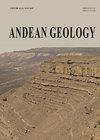阿根廷帕甘佐盆地rio Francia地区古生代晚期地层学、古环境与相关性
IF 1.2
4区 地球科学
Q3 GEOLOGY
引用次数: 0
摘要
Tupe和Patquía地层以其海相、三角洲、河流和风成沉积而闻名,这些沉积记录了Paganzo盆地晚古生代的不同事件。然而,在Río Francia(阿根廷圣胡安省)地区,这些单元是相关的,因为它们位于连接中部Precordillera的Paganzo盆地最南端沉积序列的战略位置。Tupe组(根据孢粉学资料可代表Serpukhovian-Gzhelian晚段)的生物泥岩厚度最小为140 m,其间穿插少量粗砂岩和细砂岩。在这项工作中,它们被分为3个相组:I泻湖;II堰洲岛和III岸面。Patquía组(根据本区孢粉学资料,属于西苏拉系)为典型的红层序,砂泥岩交替,细粒砂岩呈交错层理沉积。分3种相组合:IV吻合河相;V风和VI playa湖。通过对比分析这些地层及其对应的岩石地层,为Paganzo盆地西部提供了可能的情景,显示出这些纬度的Tupe组和对应的地层单元具有海岸环境特征。另一方面,Patquía组及其等效组表现出自北向南的渐进大陆化。本文章由计算机程序翻译,如有差异,请以英文原文为准。
Estratigrafía, paleoambientes y correlación del Paleozoico Superior en la localidad Río Francia, Cuenca Paganzo, Argentina
The Tupe and Patquía formations are known for their marine, deltaic, river, and eolian deposits that record different Late Paleozoic events in the Paganzo Basin. However, in the area of the Río Francia (Province of San Juan, Argentina), these units are relevant because they are located in a strategic place of connection with the southernmost sedimentary sequences in the Paganzo Basin on the Central Precordillera. The Tupe Formation (which by palynological data would represent the late Serpukhovian-Gzhelian interval) has a minimum thickness of 140 m of bioturbed mudstones with a minor percentage of coarse to fine sandstones intercalated. In this work they are grouped into 3 facies associations: I lagoon; II barrier island and III shoreface. The Patquía Formation (from palynological data, in this locality, of Cisuralian in age), it is a typical succession of red beds with deposits of fine -grained sandstones with cross-bedding, and alternation of sandstones with mudstones. 3 facies associations were differentiated: IV anastomosed fluvial; V eolian and VI playa lake. A correlation analysis between these formations and their lithostratigraphic equivalents provided possible scenarios for the western sector of the Paganzo Basin, showing a lineament of units with coastal environment features for the Tupe Formation and equivalents at these latitudes. On the other hand, the Patquía Formation and their equivalents display a progressive continentalization from north to south.
求助全文
通过发布文献求助,成功后即可免费获取论文全文。
去求助
来源期刊

Andean Geology
地学-地质学
CiteScore
3.90
自引率
0.00%
发文量
17
审稿时长
>12 weeks
期刊介绍:
This journal publishes original and review articles on geology and related sciences, in Spanish or English, in three issues a year (January, May and September). Articles or notes on major topics of broad interest in Earth Sciences dealing with the geology of South and Central America and Antarctica, and particularly of the Andes, are welcomed.
The journal is interested in publishing thematic sets of papers and accepts articles dealing with systematic Paleontology only if their main focus is the chronostratigraphical, paleoecological and/or paleogeographical importance of the taxa described therein.
 求助内容:
求助内容: 应助结果提醒方式:
应助结果提醒方式:


